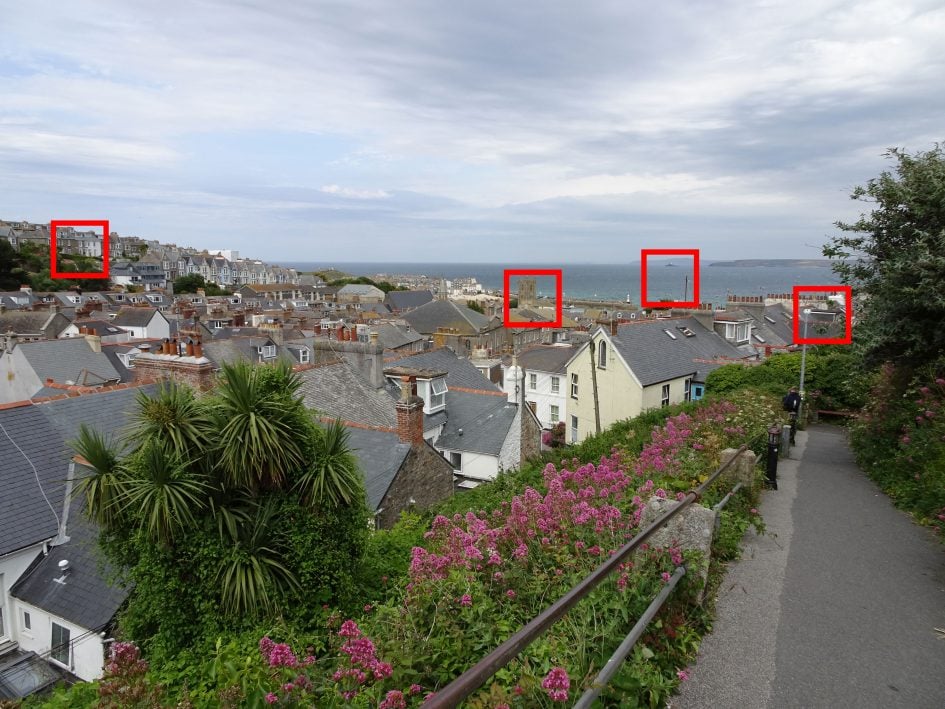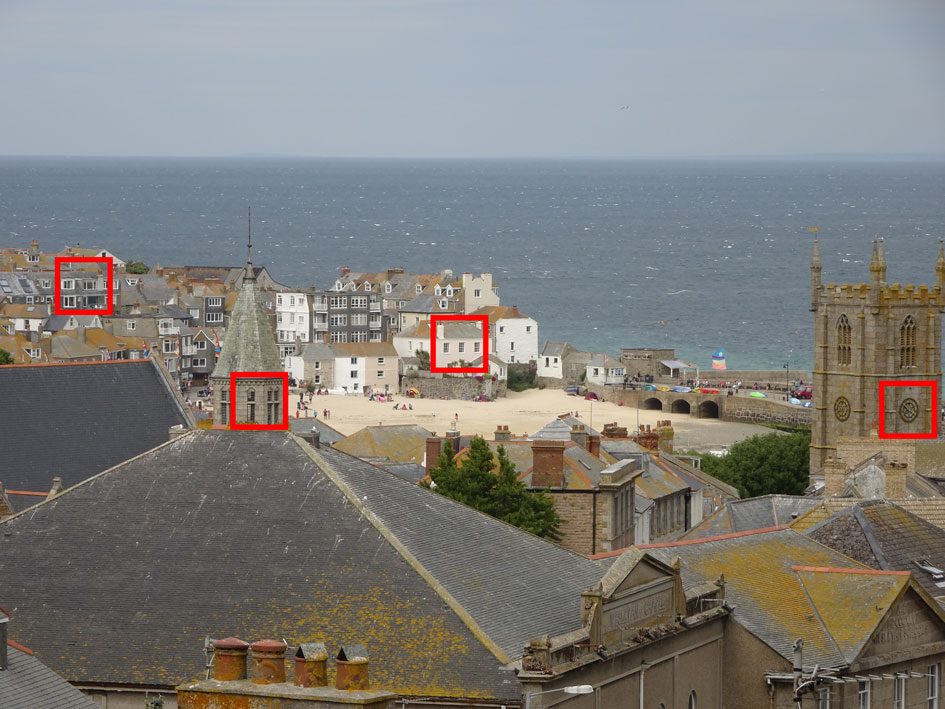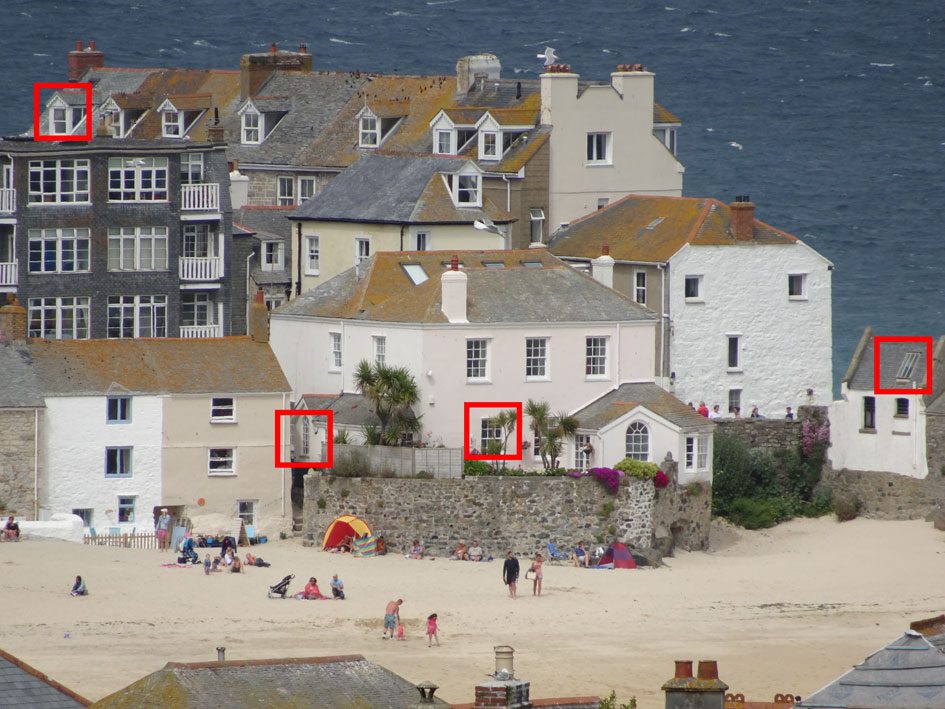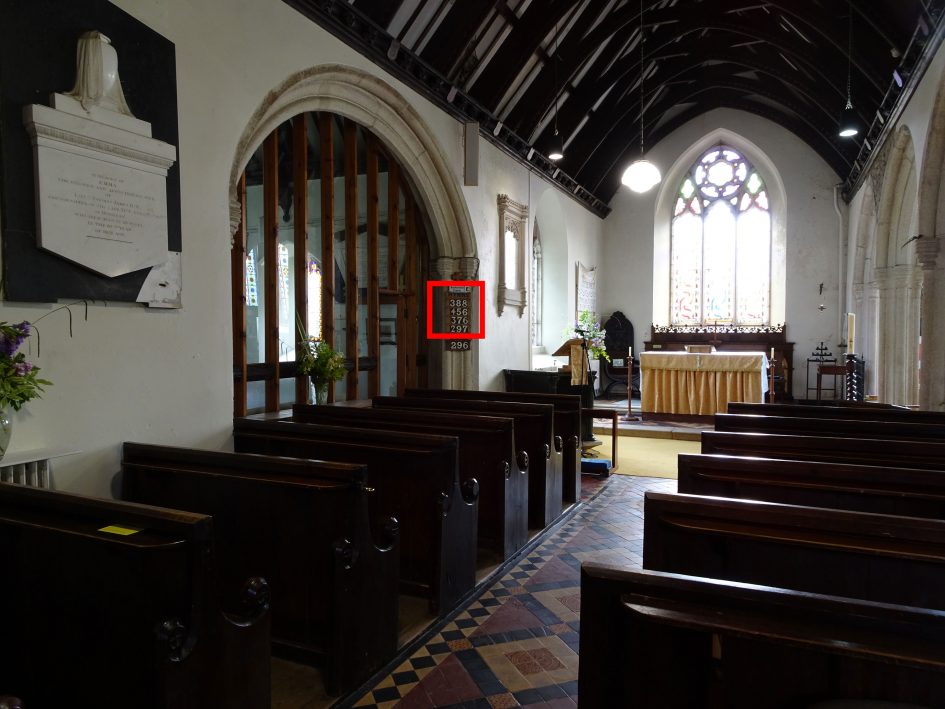Sony Cyber-shot HX90V review
-
-
Written by Ken McMahon
Quality
Sony HX90V vs COOLPIX S9900 vs Panasonic Lumix TZ70 / ZS50 quality results
To compare real-life performance, I shot this scene with the Sony Cyber-shot HX90V, the Nikon COOLPIX S9900 and the Panasonic Lumix TZ70 / ZS50 within a few moments of each other, using their best quality JPEG settings and at their base sensitivity settings. All three cameras were set to their maximum wide angle setting. At 25mm equivalent, the COOLPIX S9900 has a slightly narrower field of view than the 24mm Sony HX90V and Lumix TZ70 / ZS50. In practice, however, the difference is quite small and it proved impractical to zoom the HX90V and TZ70 / ZS50 in by such a small amount.
For this test the cameras were mounted on a tripod and image stabilisation was disabled except on the HX90V where it can’t be turned off. The ISO sensitivity was manually set to the lowest available setting and for the wide angle shots all three models were set to f4 in aperture priority mode. All other settings were left on the defaults.

Overall, the HX90V has produced an excellent set of crops with a good level of detail and very little distortion. In the first crop from close to the left edge of the frame the detail is a little less distinct than at the centre of the frame, and the final crop from the opposite edge looks very similar. The second crop taken from closer to the middle of the frame is sharper and shows more of the finer detail, though you can’t quite make out the time on the church clock.
There’s also a good level of detail in the third crop, though the lighthouse is a little less clear than it might have been due to atmospheric haze. The other thing that’s visible in all the crops, but most noticeable here is the low level noise – a granular texture that’s most obvious in the area around the lighthouse.
Compared with the crops from the Nikon COOLPIX S9900 it looks to me like the HX90V has more detail both at the centre and the edges of the frame. The 16 Megapixel sensor of the COOLPIX S9900 produces a larger crop area with slightly smaller detail than the 18 Megapixel HX90V, but I think the HX90V’s lens is mostly responsible for its sharper, more detailed crops.
The size difference is more pronounced on the crops from the 12 Megapixel Lumix TZ70 / ZS50 but despite that I reckon you can see just a little more detail in the Lumix crops – there’s also less evidence of noise. Next scroll down for a comparison at around 180mm equivalent.

Above left: Sony H90V at 4.1mm (24mm equivalent) f4, 80 ISO. Above center: COOLPIX S9900 at 4.5mm (25mm equivalent) f4, 125 ISO. Above right: Lumix TZ70 / ZS50
at 4.3mm (24mm equivalent) f4, 80 ISO.

Above left: Sony H90V at 4.1mm (24mm equivalent) f4, 80 ISO. Above center: COOLPIX S9900 at 4.5mm (25mm equivalent) f4, 125 ISO. Above right: Lumix TZ70 / ZS50
at 4.3mm (24mm equivalent) f4, 80 ISO.

Above left: Sony H90V at 4.1mm (24mm equivalent) f4, 80 ISO. Above center: COOLPIX S9900 at 4.5mm (25mm equivalent) f4, 125 ISO. Above right: Lumix TZ70 / ZS50
at 4.3mm (24mm equivalent) f4, 80 ISO.

Above left: Sony H90V at 4.1mm (24mm equivalent) f4, 80 ISO. Above center: COOLPIX S9900 at 4.5mm (25mm equivalent) f4, 125 ISO. Above right: Lumix TZ70 / ZS50
at 4.3mm (24mm equivalent) f4, 80 ISO.
Sony HX90V vs COOLPIX S9900 vs Panasonic Lumix TZ70 / ZS50 quality at 180mm equivalent

The second set of crops was taken with the lens zoomed in to around 180mm equivalent which provides a field of view that you can see in the main image above. Once again the results from the HX90V are good overall and at this focal length are more consistent, with little difference between the edge and centre crops. Now though, there’s little to tell between the Sony HX90V and COOLPIX S9900 crops which is also consistent from the edge of the frame to the centre. That supports the conclusion that it’s the HX90V’s superior lens, rather than the sensor that gives it the quality edge at the wider end of the zoom range. The Lumix TZ70 / ZS50’s less noisy crops come out on top though, vindicating Panasonic’s decision to pull back from ever increasing Megapixel counts on its compact sensors. Scroll down to see how they compare at their longest focal lengths.

Above left: Sony H90V at 30mm (175mm equivalent) f6.3, 80 ISO. Above center: COOLPIX S9900 at 34mm (188mm equivalent) f6.3, 125 ISO. Above right: Lumix TZ70 / ZS50 at 33mm (184mm equivalent) f6.3, 80 ISO.

Above left: Sony H90V at 30mm (175mm equivalent) f6.3, 80 ISO. Above center: COOLPIX S9900 at 34mm (188mm equivalent) f6.3, 125 ISO. Above right: Lumix TZ70 / ZS50 at 33mm (184mm equivalent) f6.3, 80 ISO.

Above left: Sony H90V at 30mm (175mm equivalent) f6.3, 80 ISO. Above center: COOLPIX S9900 at 34mm (188mm equivalent) f6.3, 125 ISO. Above right: Lumix TZ70 / ZS50 at 33mm (184mm equivalent) f6.3, 80 ISO.

Above left: Sony H90V at 30mm (175mm equivalent) f6.3, 80 ISO. Above center: COOLPIX S9900 at 34mm (188mm equivalent) f6.3, 125 ISO. Above right: Lumix TZ70 / ZS50 at 33mm (184mm equivalent) f6.3, 80 ISO.
Sony HX90V vs COOLPIX S9900 vs Panasonic Lumix TZ70 / ZS50 quality at 720mm equivalent

The final set of crops was shot at the maximum zoom range of all three models – 720mm equivalent on the Sony HX90V and Lumix TZ70 / ZS50 and 750mm on the COOLPIX S9900; you can see the full view above. Here, there’s some impact of heat rising, but still a quality gap opens up between the Sony HX90V and the COOLPIX S9900 with the HX90V producing sharper crops with better detail right across the frame. Once again though, it’s the Lumix TZ70 / ZS50 that wins the day. Although its 12 Megapixel sensor produces smaller detail, there’s more of it and it’s sharper than the results from either the Sony HX90V or the COOLPIX S9900. But how do they compare at higher sensitivities? Find out in my Sony HX90V noise results, or skip to my Sony HX90V sample images, or head straight to my verdict.

Above left: Sony H90V at 123mm (720mm equivalent) f6.4, 80 ISO. Above center: COOLPIX S9900 at 135mm (750mm equivalent) f6.4, 125 ISO. Above right: Lumix TZ70 / ZS50 at 129mm (720mm equivalent) f6.4, 80 ISO.

Above left: Sony H90V at 123mm (720mm equivalent) f6.4, 80 ISO. Above center: COOLPIX S9900 at 135mm (750mm equivalent) f6.4, 125 ISO. Above right: Lumix TZ70 / ZS50 at 129mm (720mm equivalent) f6.4, 80 ISO.

Above left: Sony H90V at 123mm (720mm equivalent) f6.4, 80 ISO. Above center: COOLPIX S9900 at 135mm (750mm equivalent) f6.4, 125 ISO. Above right: Lumix TZ70 / ZS50 at 129mm (720mm equivalent) f6.4, 80 ISO.

Above left: Sony H90V at 123mm (720mm equivalent) f6.4, 80 ISO. Above center: COOLPIX S9900 at 135mm (750mm equivalent) f6.4, 125 ISO. Above right: Lumix TZ70 / ZS50 at 129mm (720mm equivalent) f6.4, 80 ISO.
Sony HX90V vs COOLPIX S9900 vs Lumix TZ70 / ZS50 noise results
To compare noise levels under real-life conditions, I shot this scene with the Sony HX90V, the Nikon COOLPIX S9900 and the Panasonic Lumix TZ70 / ZS50 within a few moments of each other at each of their ISO settings. All three cameras were set to their best quality JPEG modes and mounted on a tripod. Stabilisation was disabled except on the HX90V where it can’t be turned off. Auto DRO was disabled on the HX90V, but otherwise the cameras were left on their default settings.
All three cameras were set to their maximum wide angle setting. At 25mm equivalent, the COOLPIX S9900 has a slightly narrower field of view than the 24mm Sony HX90V and Lumix TZ70 / ZS50. In practice, however, the difference is quite small and it proved impractical to zoom the HX90V and TZ70 / ZS50 in by such a small amount.

All three cameras were set to f4 in aperture priority mode. At 80 ISO the HX90V and TZ70 / ZS50 metered an exposure of 0.4s and at its base 125 ISO sensitivity the COOLPIX S9900 metered 1/6s. I took crops from each ISO setting from each camera and have presented them below at 100 percent; the cropped area is marked by a red square on the image above.
The first crop from the HX90V at its base 80 ISO sensitivity setting isn’t noise free. You can clearly see noise texture in the flat areas of colour and it’s most obvious in the label above the hymn board. It’s low level noise but enough to slightly obscure some of the finer image detail as was evident in the crops from my outdoor quality test.
Though the noise increases slightly at 200 ISO you need to look very closely to spot it and I’d have no qualms about bumping the sensitivity up to 200 ISO if the situation demanded it. At 400 ISO though, there’s a significant jump in the noise levels. Again, nothing to be too bothered about unless you’re pixel peeping but there it is.
At 800 ISO there’s another jump up, accompanied by a slight loss in contrast. The noise is now starting to affect medium sized image detail but it’s not until 1600 ISO that the text is badly affected. At 3200 ISO it’s virtually unreadable, but at smaller sizes even at this upper limit the image quality is passable. The issue for the HX90V is not so much its noise performance through the sensitivity range, which is pretty good, but the noise level at the base 80 ISO sensitivity setting. That said, unless you’re producing big prints, or viewing your shots at 100 percent sizes on a big screen it’s not something most people are likely to be troubled by or even notice.
The COOLPIX S9900’s 16 Megapixel sensor produces a slightly larger crop area with smaller detail and at its 125 ISO base sensitivity setting it too shows evidence of noise. Nikon’s noise suppression deals with it qute effectively but as a result the finer detail is smoothed, so there’s less speckling than in the HX90V 80 ISO crop, but less detail too. It’s the same story all the way up the ISO range, with the COOLPIX S9900 applying more aggressive noise reduction resulting in less grainy, but less detailed crops. At less than 100 percent viewing sizes, there’s not much difference, but I prefer the Sony approach which accepts a little bit of graininess in return for more image detail.
The 12 Megapixel sensor in the Lumix TZ70 / ZS50 produces a larger crop area with smaller detail and the crops are significantly less noisy than those from either the HX90V or the COOLPIX S9900. The 80 ISO crop is clean and virtually noise-free compared with the one from the HX90V and the TZ70 / ZS50 maintains this advantage all the way up the sensitivity range. It tops out at 6400 ISO, but given the amount of noise in this crop, I reckon that’s a step too far. Also bear in mind that the Sony HX90V’s Multi Frame Noise Reduction feature can shoot noise-reduced composites all the way up to 12800 ISO.

Above left: Sony H90V at 80 ISO. Above center: COOLPIX S9900 80 ISO not available. Above right: Lumix TZ70 / ZS50 at 80 ISO.

Above left: Sony H90V at 100 ISO. Above center: COOLPIX S9900 at 100 ISO. Above right: Lumix TZ70 / ZS50 at 100 ISO.

Above left: Sony H90V at 200 ISO. Above center: COOLPIX S9900 at 200 ISO. Above right: Lumix TZ70 / ZS50 at 200 ISO.

Above left: Sony H90V at 400 ISO. Above center: COOLPIX S9900 at 400 ISO. Above right: Lumix TZ70 / ZS50 at 400 ISO.

Above left: Sony H90V at 800 ISO. Above center: COOLPIX S9900 at 800 ISO. Above right: Lumix TZ70 / ZS50 at 800 ISO.

Above left: Sony H90V at 1600 ISO. Above center: COOLPIX S9900 at 1600 ISO. Above right: Lumix TZ70 / ZS50 at 1600 ISO.

Above left: Sony H90V at 3200 ISO. Above center: COOLPIX S9900 at 3200 ISO. Above right: Lumix TZ70 / ZS50 at 3200 ISO.

Above left: Sony H90V 6400 ISO not available. Above center: COOLPIX S9900 at 6400 ISO. Above right: Lumix TZ70 / ZS50 at 6400 ISO.




